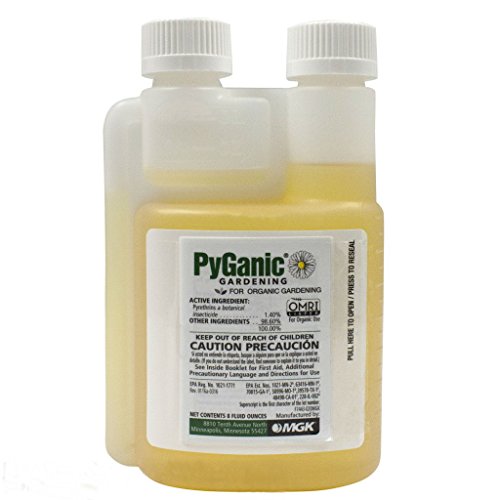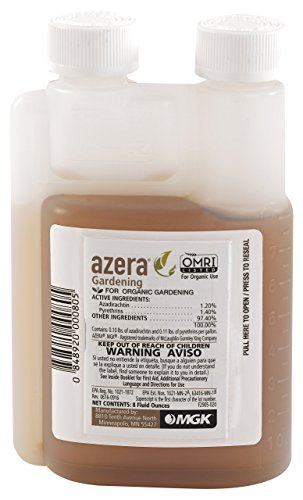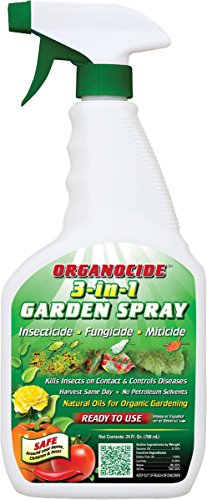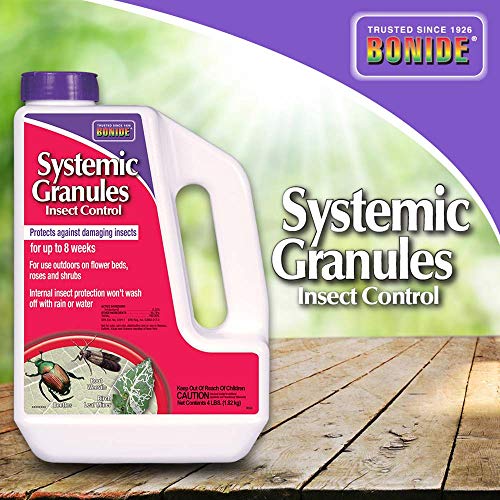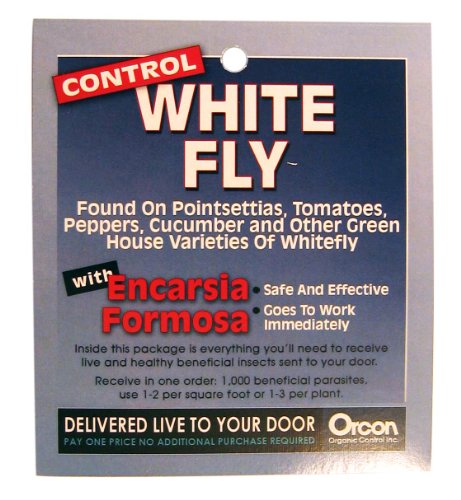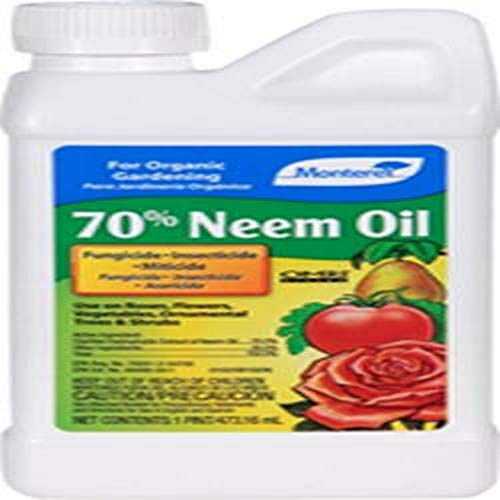How to get rid of whiteflies: 10 way to prevent and control whiteflies in your garden
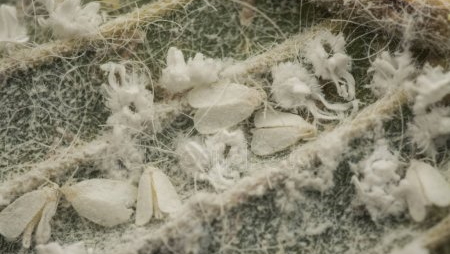
How to Prevent and Control Whiteflies in the Edible Gardens
#1 PyGanic Gardening 8oz, Botanical Insecticide (Chemical – Editors’ Choice)
It’s a broad-spectrum contact insecticide containing pyrethrins extracted from the chrysanthemums that is very effective against a variety of pests and is considered ideal for the edible gardens and can be sprayed on vegetable, fruits, and ornamentals without any fears of residual effect. To see how do you get rid of whiteflies using its powerful formula by diluting 1 to 1.4 ounces of this concentrate in 1 gallon of water. Ensure a good spray coverage using a mist sprayer. Avoid spraying during rain while it can be sprayed till the day of harvests.
#2 Ed Rosenthal’s Zero Tolerance-Herbal Pesticide (Natural – Editors’ Choice)
This herbal pesticide is made from food-grade cinnamon, thyme, rosemary, and clove oils to get rid of whiteflies and several other garden pests. It can work exceptionally well on first spotting of whiteflies on the undersides of the leaves and works as strong deterrent and killer on contact. It has no side effects and you can use it 2 weeks before any harvest.
1 quart of this concentrate makes 1 gallon of solution to be used on the entire plant foliage with the help of mist sprayer.
#3 Rubbing Alcohol (Solimo 70% Isopropyl Alcohol)
The first question that arises in your mind on first spotting them on your plants is how to get rid of whiteflies quickly?
Make a mixture of rubbing alcohol with water, liquid soap and mouth wash to wash them away using a pressurized sprayer especially on the undersides of the leaves that dislocated and kill them gradually on the ceasing of sap-sucking from the leaves.
For 10 ounces solution, add 2 ounces of rubbing alcohol, 2 ounces mouth wash, 1-ounce liquid soap and 5 ounces of tap water. Spray in the evening and monitor leaves for any sign of burning. Avoid adding liquid soap if the surrounding temperature is too high.
#4 Azera Gardening
Its combination of Azadirachtin from Neem (1.20%) and Pyrethrins from Chrysanthemums (1.40%) respectively that is very effective against whiteflies on plants in your vegetable or organic garden. Its efficient formula kills even the resistant whiteflies and other soft and hard-bodied pests like aphids and beetles in any edible garden. It naturally breaks down in sunlight that can be applied on the day to harvest fruits and vegetables. Add 1.25 ounces of this concentrate in 1 gallon of water and thoroughly spray your plants using a mist sprayer or a fogger.
#5 Organocide® Bee Safe 3-in-1 Garden Spray
Organocide contains 0.08% Sesame oil along with soybean extract and fish oil to make a powerful blend that works as an insecticide, acaricide, and fungicide together. While you have such type of product at hand that you don’t need to worry how to control whiteflies, their eggs and nymph on your garden plants and more sweetly it can be used till the time of the harvest without fearing any toxicity due to its organic nature. It doesn’t harm bees besides equally effective against sooty mold or other diseases that are associated with the whiteflies in your garden
Caring surface temperature is very important for its applications. Avoid if the temperatures exceed 95°F.
A single application is enough for complete control of whitefly on plants. You may repeat after 7 days if the infestations prolong.
Add 3 ounces of Organocide®3-in-1 Garden Spray in 1 gallon of water and shake well before use. A hand-held sprayer can do the rest of your job.
#6 Bonide – Insect Control Systemic Granules
It contains 0.22% Imidacloprid as its active ingredient. A systemic insecticide is better to use outdoors or lawns for stopping whiteflies to enter into the house. If you can manage to kill them from lawn and ornamental plants then whiteflies don’t become a menace in your gardening. Don’s put on any type of edible plants until you can wait for 3-4 weeks to harvest. It’s a granular application that is easy to apply.
Add 1 pound of granules to 8 medium sizes rose plant or shrubs of the similar type. For containers, add 2.5 tablespoons in 1 gallon of water. The application may be repeated after 8 weeks during the growing season for complete coverage of whiteflies in house and ornamental plants including lawns.
#7 Nature’s Good Guys-1,000 Encarsia Formosa Eggs (control whiteflies biologically)
These are eggs of tiny flying insects that either paralyzes Nymph by laying their eggs inside them or eat it up altogether. They don’t interfere with the activity of other beneficial insects but in harmony with them. Hanging cards containing these insects are placed on the lower leaves of the plants that need immediate release upon arriving at your garden. They are capable of controlling several traits of whiteflies and are often not noticeable in the garden. Releasing and hanging these cards on your edible plants is quite an easy job.
#8 Beneficial Delphastus Pusillus-White Fly Predator (control whiteflies biologically)
It’s a small black beetle that is the voracious eater of all existing strains of whiteflies including giant whitefly. If whiteflies disappear during or after their application, they will feed on aphids and spider mites while it’s adult and larva both remain active in preying all stages except flying adults of whiteflies in your edible garden. On average, 1 beetle can prey as many as 150 eggs in a day. Pack contains a group of 25 beetles that are fairly easy to release in your garden.
#9 Monterey -70% Neem Oil (16 Ounce) (control whiteflies organically)
The question arising from the edible gardeners that how to control whiteflies organically is over now as this product is specially made from Neem extracts that has the ability to prevent and control several pests including whiteflies, aphids and spider mites on vegetables & fruits, ornamental & shrubs, roses & flower along with the fungicidal properties to work against Downy & Powdery mildew, leaf spot and rust wilts. It immediately breaks down into organic matter after its applications & never does any harm to edible plants.
This product is more effective if applied after every 10 days. For heavier infestations, spray after every 7 days.
Add 1 ounce of 70% Neem oil in a gallon of water and spray your plants using a Pressurized sprayer washing them from upside down.
#10 Garden Safe Brand Insecticidal Soap Insect Killer (control whiteflies organically)
It’s another ready to use a product from the range of organic insecticides which contains 1% Potassium salts of Fatty Acids that doesn’t let whiteflies to change their instar and they die of starvation in the process. It’s a contact poison and damages cell membrane of the all soft-bodied insects. It can also be used until the time of the harvest without any residual effects on the edible plants. No need to make any mixture, just pick the pack and fix whiteflies at the spot.
What are whiteflies and where do they come from?
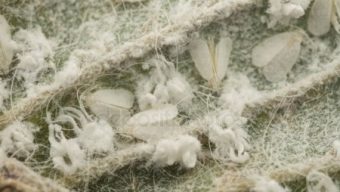 Coming towards identifying these tiny creators you must be carious that what do whiteflies look like? It’s not hidden anyways that they belong to class Insecta and the most common occurring strains in the US climate are Bemisia argentifolii and Bemisia tabaci where B.argentifolii is also called silver leaf whitefly. Most of the species have a wingspan of 3 mm or even less, the body is 1 mm to 2 mm long. Some giant whiteflies have length up to 5 millimeters. They are small tiny insects when flying and tiny, flattened, oval scales when present undersides of the leaves as Nymphs where they are hardly noticed due to their hiding locations. B.argentifolii is usually causing the biggest destructions in the vegetables and fruit orchards while B. tabaci causes more destruction to the field crops such as Tobacco, Cotton, and Cereals. The best time to identify any of these strains is during their Nymph stage when they are present undersides of the leaves busy in sucking sap from the newly emerged leaves and tender shoots. They develop red eyespot upon changing their instar from Nymph to adult stages of their growth. The pupa of the Silver leaf whitefly looks rounded and dome and even pointed sometimes. The pupa has no filaments. They have several pairs of wax filaments arising from the top. Adults are generally white, as their name indicates, although the body of the Silver leaf is slightly more yellow. However, their color alone is not the basis for their identification but the difference in the angle of their wings to their body.
Coming towards identifying these tiny creators you must be carious that what do whiteflies look like? It’s not hidden anyways that they belong to class Insecta and the most common occurring strains in the US climate are Bemisia argentifolii and Bemisia tabaci where B.argentifolii is also called silver leaf whitefly. Most of the species have a wingspan of 3 mm or even less, the body is 1 mm to 2 mm long. Some giant whiteflies have length up to 5 millimeters. They are small tiny insects when flying and tiny, flattened, oval scales when present undersides of the leaves as Nymphs where they are hardly noticed due to their hiding locations. B.argentifolii is usually causing the biggest destructions in the vegetables and fruit orchards while B. tabaci causes more destruction to the field crops such as Tobacco, Cotton, and Cereals. The best time to identify any of these strains is during their Nymph stage when they are present undersides of the leaves busy in sucking sap from the newly emerged leaves and tender shoots. They develop red eyespot upon changing their instar from Nymph to adult stages of their growth. The pupa of the Silver leaf whitefly looks rounded and dome and even pointed sometimes. The pupa has no filaments. They have several pairs of wax filaments arising from the top. Adults are generally white, as their name indicates, although the body of the Silver leaf is slightly more yellow. However, their color alone is not the basis for their identification but the difference in the angle of their wings to their body.
How do whiteflies damage plants?
Generally speaking, gardeners don’t like plants infested or damaged by whiteflies when they visit nurseries to buy plants as the quality of the plants deteriorate after they are infested with whiteflies and its not wise decision to bring already infested plants to your edible garden that may damage your existing plants. Whiteflies infest numerous garden plants by sticking them to the undersides of the leaves with the help of stylus that they insert into the epidermal leaf layer and suck the plant sap. Besides sucking sap they secrete sticky saliva on the surface of the leaves that creates an ideal media to attract sooty mold and many other fungi diseases. Whiteflies are also considered the carriers of tomato yellow leaf curl virus (TYLC) and Gemini Virus on Cotton causing (CLCV) which are hard to recover and diminishes thousands of acres of standing crops in the growing season.
What is the lifecycle of whiteflies?
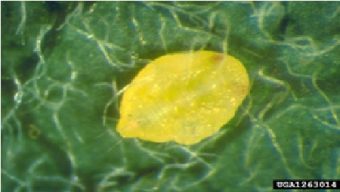 Females often lay down eggs on the undersides of leaves, shoot curvatures and undersides of buds on the plant. Eggs numbers vary from 200 to 300 depending on the temperature and humidity in any particular area. A female may live up to 45 days that again depends on temperature. All life stages are passed on the same host plant except for the adult stage that migrates to neighboring plants. Eggs are in the form of tiny spindles in semi-circles. Hatching takes place in 8-10 days at 65°-75°F. Upon hatching, nymphs remain stick to the leaves for their feed until they pass other stages to become a flying adult. Depending on the temperatures, whiteflies may have 11 to 23 generations annually. It’s advisable to make necessary arrangements to control them when their populations exceed 5 adults per leaf or 10 Nymphs/leaf but it’s much better to keep them in control before they start flying to other plants to infest them.
Females often lay down eggs on the undersides of leaves, shoot curvatures and undersides of buds on the plant. Eggs numbers vary from 200 to 300 depending on the temperature and humidity in any particular area. A female may live up to 45 days that again depends on temperature. All life stages are passed on the same host plant except for the adult stage that migrates to neighboring plants. Eggs are in the form of tiny spindles in semi-circles. Hatching takes place in 8-10 days at 65°-75°F. Upon hatching, nymphs remain stick to the leaves for their feed until they pass other stages to become a flying adult. Depending on the temperatures, whiteflies may have 11 to 23 generations annually. It’s advisable to make necessary arrangements to control them when their populations exceed 5 adults per leaf or 10 Nymphs/leaf but it’s much better to keep them in control before they start flying to other plants to infest them.
Rapid multiplication of whiteflies does compel the serious gardeners to look into prevention and control techniques that are organic, natural and biological for a sustainable control without leaving residual effects on the edibles and their health as well. We will consider these techniques but our priority is how to control whiteflies organically.
Before we go into the further details look into the cultural practices that help prevent and know how to get rid of whiteflies naturally;
How to prevent whiteflies in your garden?
- Induce the culture of raising beneficial insects such as parasitic wasps, lacewings and ladybird beetle and create an environment to invite small predatory birds to live on these flies.
- Don’t bring infested plants to your garden area from the outside climate or nurseries.
- Hang yellow sticky traps and cards having a thin layer of petroleum jelly to control early invasions.
- Initiate removal host plants especially weeds, plant debris and stubbles from your gardening landscape.
- Avoid overpopulating your space and observe fair distances while growing new plants in your indoor gardens.
- Don’t over-fertilize with excessive Nitrogen applications as it invites whiteflies to infest plants.
- Maintain air crossing among the plants and a fare interval between successive watering.

